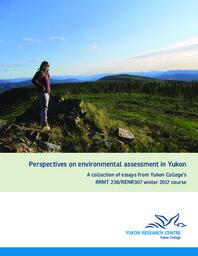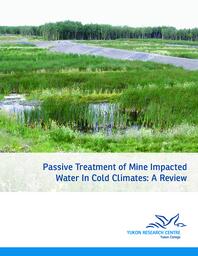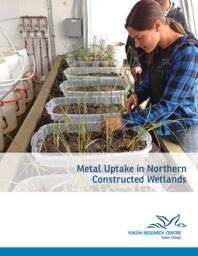Casino Mining Corporation
Related Works
Content type
Digital Document
Description / Synopsis
Environmental and socio-economic effects assessment ensures that the effects of development activities are considered before they happen and that significant adverse effects will be mitigated. Dr. Amelie Janin, NSERC Industrial Research Chair in Mine Life Cycle at Yukon College taught this course over the Winter 2017. Through discussions with a series of guest speakers and with the instructor, the students were tasked to reflect on the environmental assessment process in Yukon and to write short essays. The essays have been compiled under one document.
Origin Information
Content type
Digital Document
Description / Synopsis
In this review, we evaluate the challenges encountered and the adaptations required for the successful treatment of mine-impacted waters in cold climates with Passive Treatment Systems (PTSs). Engineered PTSs are modeled on natural wetlands, which have been shown to effectively treat water with high metal concentrations through natural attenuation. PTSs include constructed wetlands, bioreactors, and hybrid systems. Some of the challenges associated with implementing cold climate PTSs include cold temperatures, remote locations and limited access in winter, which can lead to freezing pipes and surface water, variable seasonal flow, and low productivity of microbial and macrophytic communities. Many adaptations have been implemented to address these cold climate challenges including burial of pipes to avoid hydraulic failure, insulation to avoid freezing surface waters, bypasses and overflows to maintain constant flow, summer establishment of microbial and macrophytic communities and the addition of liquid carbon sources to offset reduced organic matter decomposition in cold temperatures. While further investigation and development is necessary to fully understand the factors affecting cold climate PTSs, with sufficient research and planning PTSs can be successfully implemented in cold climates.
Origin Information
Content type
Digital Document
Description / Synopsis
Constructed wetlands (CWs) have been employed as passive treatment systems for metal contaminated mine drainage in Canada. However, relatively few CWs have been documented in northern environments and further studies are needed to understand the metal removal mechanisms in wetlands operating under cold climates, with short growing seasons. The goal of this study was to evaluate the performance of laboratory-scale CWs for the removal of Cd, Cu, Se and Zn, as well as, to evaluate Cu and Se uptake in two northern plant species (Carex aquatilis and Juncus balticus). Eight laboratory-scale wetlands were constructed using local materials, including locally harvested plant species and microorganisms and operated under northern summer conditions for 10 weeks. The CWs were fed continuously with synthetic influent containing Cd, Cu, Fe, Se and Zn at concentrations predicted at mine closure. Average removal efficiencies of 96%, 99%, 79% and 97% were observed for Cd, Cu, Se and Zn respectively. There were no significant differences in plant establishment or growth between our CW treatments, or any evidence of increasing Cu uptake with increasing contaminant availability in either northern plant species. Increased belowground uptake of Se was observed at the higher influent concentration in the Pit treatment. However, overall our study suggests that uptake of contaminants by these two northern species is very minor (<0.06% Cu and <0.11% Se, except for C. aquatilis in one treatment <0.2% Cu and <0.4 % Se) and likely does not pose a risk to the surrounding environment. We conclude that CWs could operate as successful passive treatment solutions in a northern environment, at least during the summer months, pending further studies on winter treatment. Further studies are required to examine seasonal metal removal rates in relation to rates of sulfate reduction, carbon consumption, metal precipitation and sorption. In addition, potential contaminant uptake and the influence of functional plant characteristics on metal removal in a suite of northern plant species would further assist in the development of large-scale long-term northern CWs.
Origin Information



